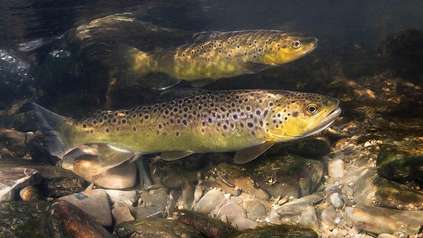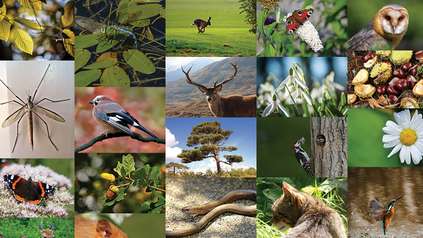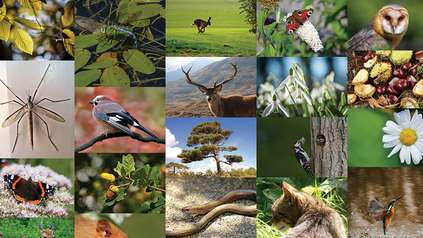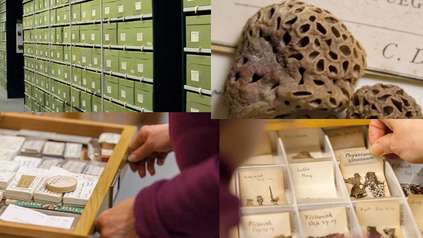Brown trout genome will help explain species' genetic superpowers
Better conservation and management of fish stocks is on the horizon, after the completion of the brown trout reference genome by scientists at the Wellcome Sanger Institute and their collaborators. The genome will help settle a longstanding debate about whether the physically-varied brown trout is actually a single species or several, and give insights into their ability to quickly adapt to multiple environments.
The newly-sequenced brown trout genome will allow scientists and conservationists to better understand the genetic roots of this highly specialised species. It will enable researchers to identify any sub-species currently classified as brown trout, facilitating conservation efforts targeted at specific populations during a period of rapid climatic change.
Brown trout (Salmo trutta) are one of the most genetically diverse vertebrates. Taxonomists once classified the species as up to 50 distinct species*. Different populations have adapted to exploit particular biological niches, with some living their whole lives within a 200 metre stretch of freshwater stream while others migrate from the stream where they were born to the open sea.
These different life strategies help to explain the genetic ‘superpowers’ of brown trout – in particular, the adaptation that allows them to move between marine and freshwater environments. As a result of this trait, brown trout was one of the first species to recolonise previously frozen freshwater areas from the sea at the end of the last ice age.
However, scientists believe we may have been too hasty in lumping all brown trout populations into one species – the consequence being that effective conservation and management is limited without knowing a species’ precise life cycle and habits.
“The new brown trout reference genome is a game-changer for us – we’ll finally be able to the settle the debate about how many species of brown trout there are. If you think in terms of conservation, if you’re managing different species as one single species, it actually undermines what you’re trying to do. Because you cannot protect what you don’t know exists.”
Professor Paolo Prodohl Of the School of Biological Sciences at Queen’s University Belfast
The brown trout reference genome will enable scientists to sample and decode DNA from different populations and compare to the whole genome sequence, providing the data required to answer questions of sub-speciation and to learn how particular genetic variations allow certain trout to live in habitats that would be fatal to others. Pinpointing genetic variations that allow Scottish loch trout to adapt to living in relatively acidic waters, for example, may be useful in guiding conservation efforts to protect populations affected by increasing acidity in rivers and oceans as a result of global heating.
Due to the genetic complexity and diversity of the brown trout, which has 38 to 40 chromosomes and multiple copies of those chromosomes within its genome*, specimens with only one set of chromosomes were specially bred by Norway’s Institute of Marine Research. Scientists at Wellcome Sanger Institute extracted DNA from these specimens and used PacBio SMRT® Sequencing technology to generate the first, high-quality brown trout reference genome.
“Given the variability of brown trout in the wild, it was important that we could create a number of genetically identical individuals to build the reference genome. Now that we have the genome, we can begin to learn more about how trout adapt to different conditions, helping the management of wild and farmed fish stocks in future.”
Principal scientist Tom Hansen Of the Institute of Marine Research in Norway, who bred the fish used in the genome sequencing
The brown trout is one of the 25 UK species to have been sequenced as part of the Sanger Institute’s 25th anniversary 25 Genomes Project. The 25 Genomes Project** includes species such as grey and red squirrels, golden eagle, blackberry and robin. The project has laid the groundwork for the ambitious Darwin Tree of Life Project**, which will sequence all 60,000 complex species in the UK.
The high-quality genomes will open doors for scientists to use this information to discover how UK species are responding to environmental pressures, and what secrets they hold in their genetics that enables them to flourish, or flounder.
“It’s fantastic that we can contribute the genome of such an interesting species as the brown trout to our growing store of knowledge. It will help scientists and conservationists the world over to discover the genetic secrets that make this species so unique. With every species we sequence, we’re learning lessons that will help us step up to the challenge of creating genomes for all complex species in the UK.”
Professor Mark Blaxter Programme Lead for the Tree of Life programme at the Wellcome Sanger Institute
More information
*For a wide range of amazing trout facts, visit https://www.wildtrout.org/trout-facts
**For more information on the 25 Genomes Project, visit https://www.sanger.ac.uk/collaboration/25-genomes-25-years
***For more information on the Darwin Tree of Life Project, visit: https://www.sanger.ac.uk/programme/tree-of-life
Funding:
The 25 Genomes project and Tree of Life programme at the Wellcome Sanger Institute are supported by Wellcome.
Selected websites
The Wild Trout Trust
We’re a conservation charity working across Britain and Ireland to help anyone interested in making a better world for our rivers, lakes and their wildlife, including our native trout. Flourishing wild trout populations are a sign of the health of our waterways and the land around them. Our team of expert Conservation Officers work with landowners, local communities, fishing clubs, rivers trusts and government agencies to offer practical advice and hands-on habitat improvement projects. https://www.wildtrout.org/
Queen’s University Belfast
The School of Biological Sciences comprises two main research groups: Ecology, Evolution, Behaviour and Environmental Economics (which includes Quercus) and Molecular Biosciences. In addition, the School houses the Institute for Global Food Security, the Gibson Institute and the Queen’s University Marine Laboratory in Portaferry. Hence, the education and research programmes supported by the School are among the most diverse in the University, with emphasis on biosciences at molecular to ecosystem levels. Find out more at http://www.qub.ac.uk/schools/SchoolofBiologicalSciences/
The Institute of Marine Research
The Institute of Marine Research (IMR) is one of the biggest marine research institutes in Europe, with about 1,000 employees. Our main activities are research, advisory work and monitoring. Find out more at https://www.hi.no/en/hi/about-us
Wellcome Sanger Institute
The Wellcome Sanger Institute is a world-leading genomics research centre. We undertake large-scale research that forms the foundations of knowledge in biology and medicine. We are open and collaborative; our data, results, tools and technologies are shared across the globe to advance science. Our ambition is vast – we take on projects that are not possible anywhere else. We use the power of genome sequencing to understand and harness the information in DNA. Funded by Wellcome, we have the freedom and support to push the boundaries of genomics. Our findings are used to improve health and to understand life on Earth. Find out more at www.sanger.ac.uk or follow us on Twitter, Facebook, LinkedIn and on our Blog.
Wellcome
Wellcome exists to improve health for everyone by helping great ideas to thrive. We’re a global charitable foundation, both politically and financially independent. We support scientists and researchers, take on big problems, fuel imaginations and spark debate. wellcome.org






